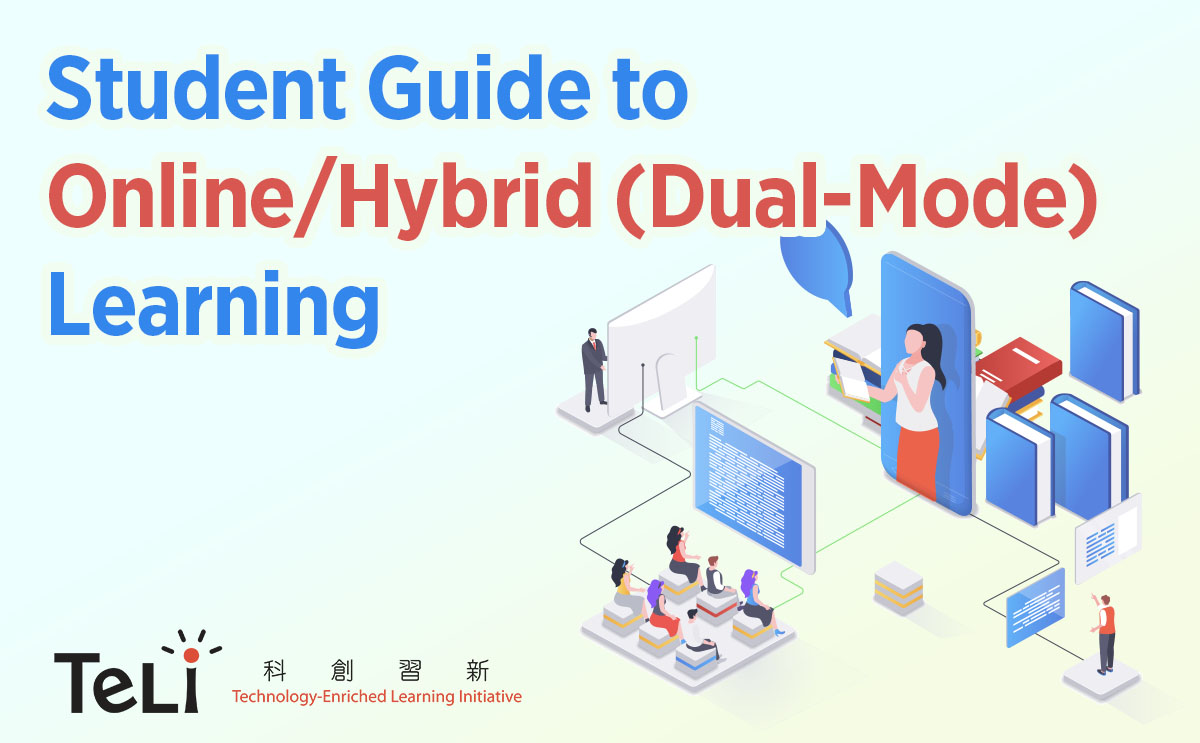
Introduction
Referring to the latest message on the S2 teaching arrangements for UG and TPG courses (for HKU UG and TPG students) released on 5 Nov 2020, course coordinators will provide one of three options of delivering lectures: online, hybrid (dual-mode), face-to-face in the Second Semester. (Only in very special circumstances will the f2f option be available.)
This Student Guide is intended to provide a guideline for students to prepare for learning in online/hybrid-mode. The information covered in this guide does not address all aspects of issues students may encounter in different learning modes but aims to help you to make the most of your learning journey.
Preparing for Online Learning
To succeed in online learning, you should be proactive, present and actively participate in discussions and other learning activities with your classmates. Here is a list of learning tips:
-
Be Familiar with the Digital Tools You Will Need to Use
Take some time to become familiar with the tools you will need to use in your courses (e.g. navigation). Explore the tools provided to ensure that the technology works on the computer/mobile device you will be using.- Your Learning Management System (e.g. HKU Moodle, HKU Online Learning, etc.)
- Teleconferencing tools (e.g. Zoom, Microsoft Teams, etc.)
- Collaborative tools (e.g. Google Slides, Google Jamboard, Miro, etc.)
- Other digital tools for your learning (e.g. Google Drive, Microsoft Office 365, Mentimeter, etc.)
- Prepare for Your Class
Here are a few checklists for you to better prepare for your class:
Before classCheck whether you have Moodle access to each of your subjects. Read the course outline and the required pre-class reading materials. Use an e-calendar to help mark assignment due dates and plan self-study hours. Laptop, earphones, and camera are ready for online sessions. Log in Zoom/Microsoft Teams with your HKU student account. Test Zoom/Microsoft Teams settings (e.g. camera on/off, audio on/off, share screen, etc.). Have a distraction-free space with a reliable Internet connection for online learning (e.g. study room, home, library, etc.). Connect to VPN (if necessary). At the beginning of the online class
Join the online meeting around 5-10 minutes before. Mute your mobile phone and log off social networks and media. Mute yourself upon entering the Zoom/Microsoft Teams meeting. Change your display name in English in Zoom/Microsoft Teams for identification. Switch on your webcam during lectures and tutorials (if possible). Add a profile picture in Zoom/Microsoft Teams if you are not able to switch on your webcam. Set up a virtual background (if necessary). During class
Stay focused and take notes of the lecture. Actively participate in the in-class discussions and other learning activities as instructed by the instructor (e.g. join a breakout room, respond to a Poll, share your work via screen sharing, etc.). Listen attentively and follow the instructions given by your course teacher (e.g. unmute yourself and speak up when it is your turn to speak, mute yourself when others are speaking). After class
Check rubrics/requirements for assignments. Check assignment due dates and submit your work on time. Book a consultation session with your course teacher/tutor if you have any questions on the course content. Contact your classmates and work together on group assignments/projects. For students who choose to come back to campus and attend a face-to-face lecture, here are some extra tips for you besides the ones listed above:
Before class
Confirm your class timetable and classroom locations. Bring your earphones. During class
Attend the face-to-face lecture, pay attention and take notes. Join the online Zoom meeting and online breakout rooms (if instructed by your course teacher). Mute yourself in Zoom/Microsoft Teams and use your earphones to avoid the echo effect in the online environment. Share your ideas and discuss with your peers who are attending online (if instructed by your course teacher). - Netiquette for Online Communication
Your communication with your peers and course instructor may take in various forms, such as via online meetings (Zoom/Microsoft Teams), Moodle discussions, or emails. Here is a list of tips for you to better interact and communicate with them online:- Respect your course instructor and peers, and communicate in a respectful tone.
- Identify yourself when you are communicating online, like showing your name in Zoom/Microsoft Teams. Professors may not be able to identify you as there are many students.
- Switch on camera during lectures and tutorials if possible.
- Introduce yourself in the email conversation/Zoom chat, and communicate with your course instructor clearly (e.g. in an email – ‘Dear Dr XXX, this is Natalie from your course MITE6023…’; in the Zoom chat – ‘Hi, I have a question on XXX – from Natalie’).
- Use clear and concise language and review what you write before sending out the message. Please use appropriate language to express your ideas.
- Protect personal privacy. Do not share your personal information or other people’s personal information in any public online forums/chat rooms.
Watch this 2-minute video to know more about Teleconferencing skills!
Resources for Online Learning
- HKU COVID-19 Info Hub: https://covid19.hku.hk/
- HKU e-Learning Resource Hub: https://elearning-resource.hku.hk/
- Teleconferencing Skills for Online Learning: https://youtu.be/XGN_hvktFbA
- How to Write Essays with Online Resources: https://youtu.be/QlKm9eFrbFA
- How to Do Collaborative Assignments: https://youtu.be/kCNiIz6II8A
Technical Support
If you encounter any difficulties, please contact the eLearning Support Team (Email: eLearningteam@hku.hk, Tel: (852) 3917 0123)

